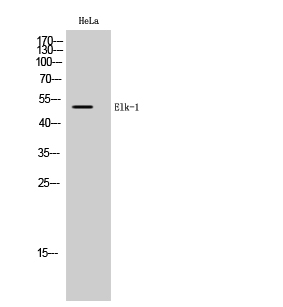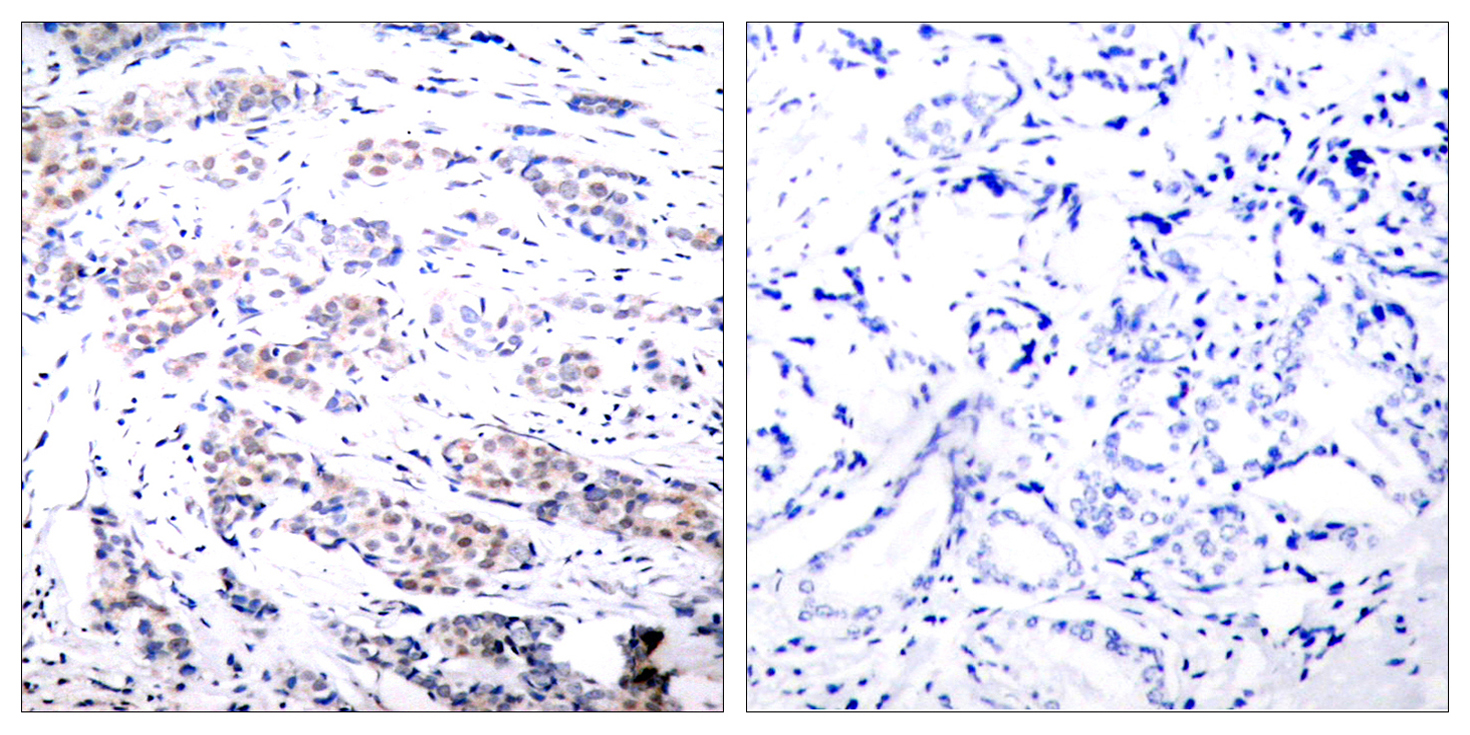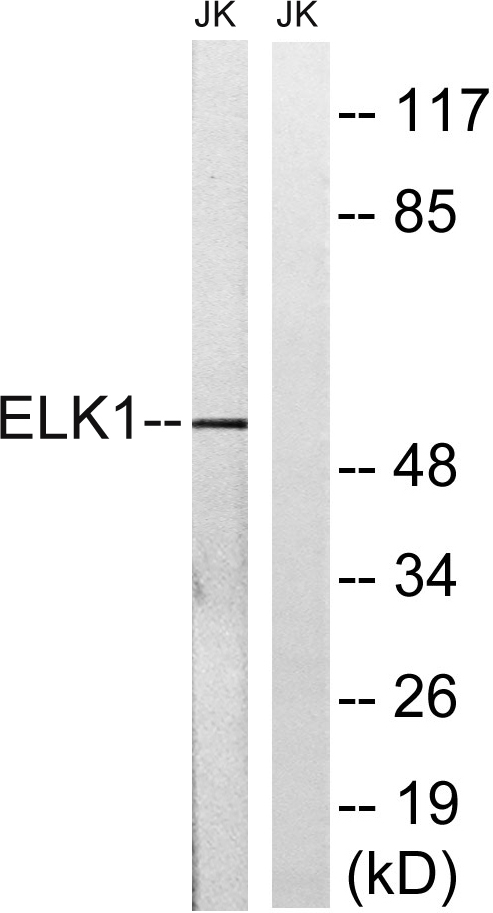Elk-1 Polyclonal Antibody
- Catalog No.:YT1527
- Applications:WB;IHC;IF;ELISA
- Reactivity:Human;Mouse;Rat
- Target:
- Elk-1
- Fields:
- >>MAPK signaling pathway;>>ErbB signaling pathway;>>Ras signaling pathway;>>Focal adhesion;>>Insulin signaling pathway;>>GnRH signaling pathway;>>Oxytocin signaling pathway;>>Leishmaniasis;>>Hepatitis B;>>Human cytomegalovirus infection;>>Human T-cell leukemia virus 1 infection;>>Pathways in cancer;>>Proteoglycans in cancer;>>Endometrial cancer;>>Hepatocellular carcinoma
- Gene Name:
- ELK1
- Protein Name:
- ETS domain-containing protein Elk-1
- Human Gene Id:
- 2002
- Human Swiss Prot No:
- P19419
- Mouse Gene Id:
- 13712
- Mouse Swiss Prot No:
- P41969
- Immunogen:
- The antiserum was produced against synthesized peptide derived from human Elk1. AA range:351-400
- Specificity:
- Elk-1 Polyclonal Antibody detects endogenous levels of Elk-1 protein.
- Formulation:
- Liquid in PBS containing 50% glycerol, 0.5% BSA and 0.02% sodium azide.
- Source:
- Polyclonal, Rabbit,IgG
- Dilution:
- WB 1:500 - 1:2000. IHC 1:100 - 1:300. IF 1:200 - 1:1000. ELISA: 1:5000. Not yet tested in other applications.
- Purification:
- The antibody was affinity-purified from rabbit antiserum by affinity-chromatography using epitope-specific immunogen.
- Concentration:
- 1 mg/ml
- Storage Stability:
- -15°C to -25°C/1 year(Do not lower than -25°C)
- Other Name:
- ELK1;ETS domain-containing protein Elk-1
- Observed Band(KD):
- 50kD
- Background:
- This gene is a member of the Ets family of transcription factors and of the ternary complex factor (TCF) subfamily. Proteins of the TCF subfamily form a ternary complex by binding to the the serum response factor and the serum response element in the promoter of the c-fos proto-oncogene. The protein encoded by this gene is a nuclear target for the ras-raf-MAPK signaling cascade. This gene produces multiple isoforms by using alternative translational start codons and by alternative splicing. Related pseudogenes have been identified on chromosomes 7 and 14. [provided by RefSeq, Mar 2012],
- Function:
- function:Stimulates transcription. Binds to purine-rich DNA sequences. Can form a ternary complex with the serum response factor and the ETS and SRF motifs of the fos serum response element.,PTM:On mitogenic stimulation, phosphorylated on C-terminal serine and threonine residues by MAPK1. Ser-383 and Ser-389 are the preferred sites for MAPK1. In vitro, phosphorylation by MAPK1 potentiates ternary complex formation with the serum responses factors, SRE and SRF. Phosphorylation leads to loss of sumoylation and restores transcriptional activator activity.,PTM:Sumoylation represses transcriptional activator activity as it results in recruitment of HDAC2 to target gene promoters which leads to decreased histone acetylation and reduced transactivator activity. It also regulates nuclear retention.,similarity:Belongs to the ETS family.,similarity:Contains 1 ETS DNA-binding domain.,subunit:Intera
- Subcellular Location:
- Nucleus.
- Expression:
- Lung and testis.
HMGB1 binding to receptor for advanced glycation end products enhances inflammatory responses of human bronchial epithelial cells by activating p38 MAPK and ERK1/2. MOLECULAR AND CELLULAR BIOCHEMISTRY Mol Cell Biochem. 2015 Jul;405(1):63-71 WB Human HBECs
- June 19-2018
- WESTERN IMMUNOBLOTTING PROTOCOL
- June 19-2018
- IMMUNOHISTOCHEMISTRY-PARAFFIN PROTOCOL
- June 19-2018
- IMMUNOFLUORESCENCE PROTOCOL
- September 08-2020
- FLOW-CYTOMEYRT-PROTOCOL
- May 20-2022
- Cell-Based ELISA│解您多样本WB检测之困扰
- July 13-2018
- CELL-BASED-ELISA-PROTOCOL-FOR-ACETYL-PROTEIN
- July 13-2018
- CELL-BASED-ELISA-PROTOCOL-FOR-PHOSPHO-PROTEIN
- July 13-2018
- Antibody-FAQs
- Products Images

- Western Blot analysis of HeLa cells using Elk-1 Polyclonal Antibody cells nucleus extracted by Minute TM Cytoplasmic and Nuclear Fractionation kit (SC-003,Inventbiotech,MN,USA).

- Immunohistochemistry analysis of paraffin-embedded human breast carcinoma tissue, using Elk1 Antibody. The picture on the right is blocked with the synthesized peptide.

- Western blot analysis of lysates from JurKat cells, using Elk1 Antibody. The lane on the right is blocked with the synthesized peptide.



